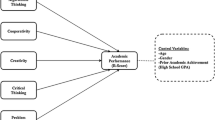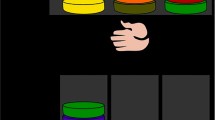Abstract
Does the way instructions for carrying out elementary operations are presented affect the time required to complete those procedures, student’s critical thinking ability, and student’s final grade? This investigation sought answers by presenting prescriptions — or algorithms — in three ways to university students in an introductory laboratory-chemistry course. Differences in the effects of the three representation modes — flow charts, lists, and standard prose — were complex and changed over the 10 lab sessions. There was no evidence that representation mode affected either critical thinking ability or final grade.
Similar content being viewed by others
References
Berlyne, D.Structure and direction in thinking. New York: Wiley, 1965.
Brown, R., & Lennenberg, E. A study in language and cognition.Journal of Abnormal and Social Psychology, 1954,49, 452–462.
Bruner, J. The course of cognitive growth.American Psychologist, 1964,19, 1–16.
Carpenter, F. The new languages. In E. Carpenter and M. McLuhan (Eds.),Explorations in communication. Boston: Beacon Press, 1960.
Chapanis, A. Words, words, words.Human Factors, 1965,7, 1–17.
Jones, S. Why can’t leaflets be logical?New Society, 1964,102, 16–17.
Landa, L.Algorithmization in learning and instruction. Englewood Cliffs, N.J.: Educational Technology Publications, 1974.
Lewis, B., Horabin, I., & Gane, C.Case studies in the use of algorithms. Oxford: Pergamon, 1967.
Lewis, B., Horabin, I., & Gane, C.Flow charts, logical trees and algorithms for rules and regulations. London: Her Majesty’s Stationery Office, 1967.
Lindquist, E. F.Design and analysis of experiments in psychology and instruction. Boston: Houghton Mifflin, 1953.
Salomon, G. Can we affect cognitive skills through visual media? An hypothesis and initial findings.AV Communication Review, 1972,20, 401–422.
Watson, G., & Glaser, E.Watson-Glaser Critical Thinking Appraisal test manual. New York: Harcourt, Brace, and World, 1964.
Wright, P., & Reid, F. Written information: Some alternatives to prose for expressing the outcomes of complex contingencies.Journal of Applied Psychology, 1973,57(2), 160–166.
Author information
Authors and Affiliations
Additional information
The authors are grateful to Martha O. Visscher and Agnes Tenny for their assistance and to Lawson Hughes for suggestions on data analysis.
Rights and permissions
About this article
Cite this article
Coscarelli, W.C., Schwen, T.M. Effects of three algorithmic representations on critical thinking, laboratory efficiency, and final grade. Educational Communication and Technology Journal 27, 58–64 (1979). https://doi.org/10.1007/BF02765317
Issue Date:
DOI: https://doi.org/10.1007/BF02765317




